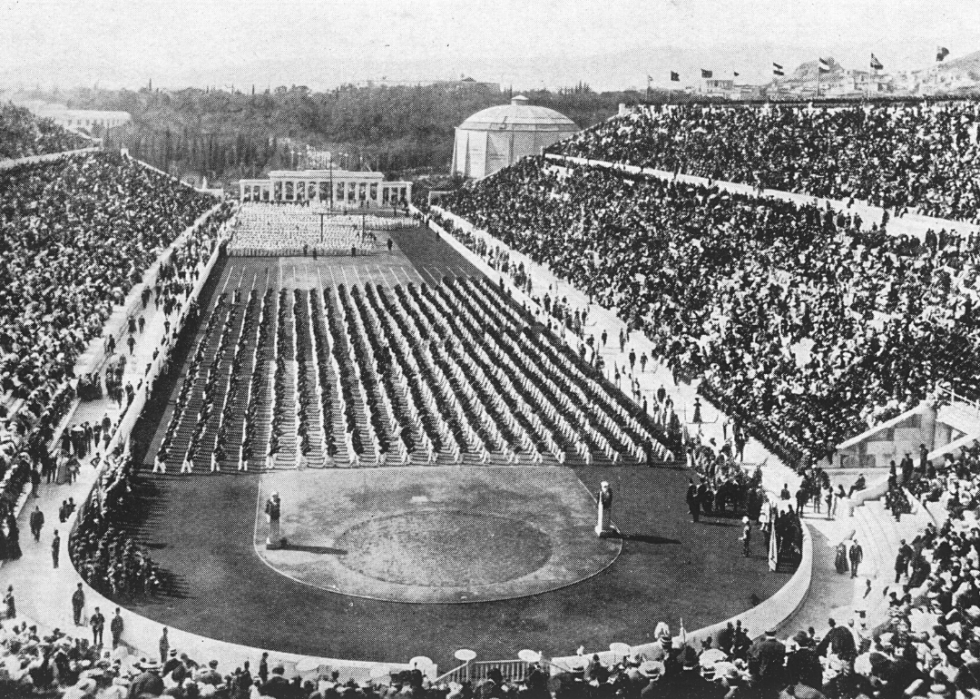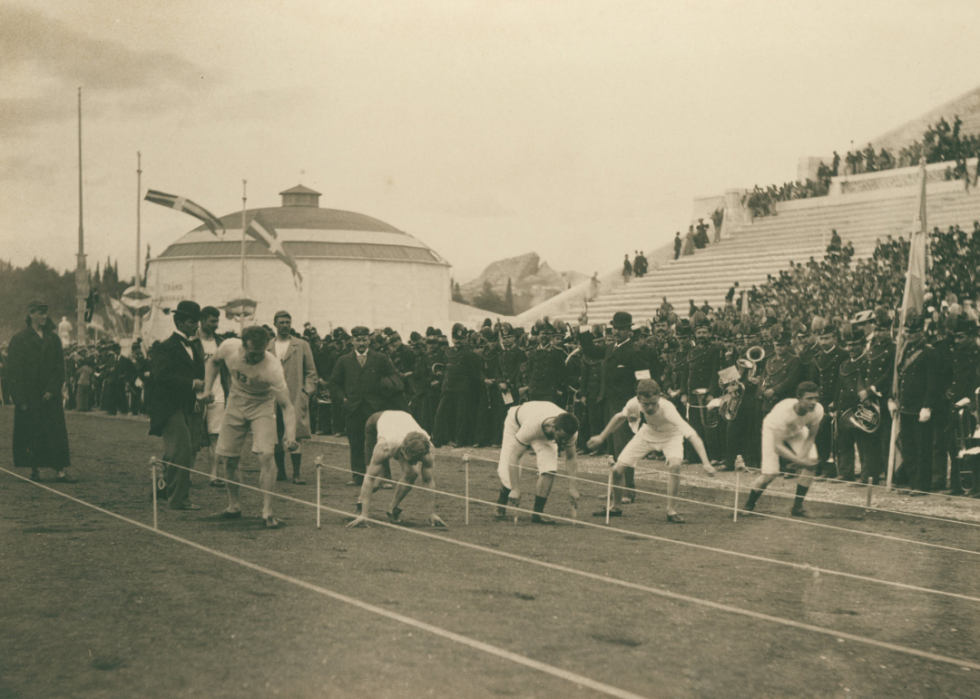Relive the Olympics Past and Present through the Lens of Professional Photographers
The 2021 Summer Olympics have come and gone. Medals were won and historic moments were witnessed. Of course, the Artisan Obscura team was interested not only in the sporting events themselves but also in the photographers behind the scenes capturing every exciting moment.
What gear do Olympic photographers use? What do photographers have to say about what it’s like shooting the Olympic games? What were the first photos ever taken at the Olympic games?
To answer these fascinating questions, we scoured the internet for articles and interviews. We’ve curated our top photography-related Olympic insights into this article. We hope you enjoy!
P.S. Scroll down for a link where you can apply to become an Olympic photographer at the next games.
Olympic Photographer Jeff Cable Reveals His 2021 Camera Setup
In July, Jeff Cable gave the public a peek into the camera gear he planned to take with him to the Tokyo games. He shoots primarily with Canon cameras (which look great with our hot shoe covers). Here are a few highlights from his blog post. Read about his full collection here.
Cable is shooting with the brand new Canon EOS R3, Canon EOS R5 (x2) and Canon EOS-1D X Mark III bodies. He notes that the latter – despite being Canon's flagship sports camera – is serving strictly as a bench warmer.
His longest lens is the Canon 200-400mm lens with the built-in teleconverter, which shoots up to 560mm. According to Cable, “I absolutely love the versatility and quality of this lens, and I know that it is perfect for shooting water polo games (which I am contractually shooting for Team USA).”
He doesn’t take storage and tech peripherals lightly either: “The two pieces of software which I rely on for everything are Photo Mechanic (by CameraBits) and Adobe Photoshop. They are installed, updated and ready to go. You can see that I have 2 of the Pro Grade Digital card readers which are magnetically attached to the Macbook Pro. I prefer this to having the reader dangling from the laptop when I am downloading on a press bus or chair. I am bringing 4 of the 2TB Crucial x8 solid state drives for backing up my images. I will have one in each bag, one in my locker at the press center and one in my hotel room. Redundant backup is crucial (pun intended).”
Photo Credit: Blog.jeffcable.com
Take a Peek into the Nikon Olympic Camera Gear Vault
Honestly, the most interesting aspect of this article for us was the sheer number of cameras on hand at the Tokyo 2021 Olympics. Treat yourself to photos of hundreds of cameras lenses all ready to be used. The Olympics boasts over 300 medal events, many of which happen at the same time. This means photographers from dozens of countries need to be equipped with gear.
The article also speculates on the lack of Nikon Z mirrorless systems. If you’re interested in sports photography and are wondering what camera body style to buy next, this article might be worth reading. Durability is definitely worth considering. From the article, “At an event such as the Olympics where tensions are running high and there’s a lot of running around for the photographers as well as the athletes, kit is bound to get damaged now and again. So, naturally, the Nikon Professional Services team is on-hand to carry out any required repairs to cameras and lenses as needed.”
Photo Credit: Vincent Kalut
What Do the OlympicTV Broadcast Cameras Look Like?
When it comes to gear and camera rigs, video cameras are an entirely different beast. Our soft release buttons aren’t designed for fully-fledged video cameras, but that doesn’t mean we should just pass over the monsters broadcasters like NBC bring to the games. This article points out that the camera lenses used to broadcast the Olympics cost as much as a Lamborghini.
The author of the article writes, “The lenses which are attached to those cameras can easily cross a price tag of $200,000.”
Why are they so expensive? According to a professional at Canon, “Some of our high-end broadcast lenses have 30-40 elements inside.” Comparing a DSLR to a video camera, the article notes, “A typical kit lens that comes with a DSLR has around 10 elements inside it.” This added complexity, in addition to increased video performance, means high-end video cameras come at a very high price tag.
Photographers Reveal their Favorite Photos from the Olympics
The New York Times conducted a series of interviews with Olympic Photographers. They asked about their favorite images from the games. As you’ll see, many of the photos chosen were taken while off the clock - they capture spontaneous, human moments from angles you’d never see during a typical broadcast.
James Hill
“David Tshama Mwenekabwe, a middleweight boxer from the Democratic Republic of Congo, is heading to the ring to fight his first ever Olympic bout. His name has just been announced to the nonexistent crowd and, as he steps into the arena, he seems equally focused and lost in his thoughts. Sweat rests on his muscular frame from a warm-up. His gloves are raised as if ready for battle. The weight of expectancy is palpable, and three rounds of three minutes, or less, will decide his fate. I chose this image as my favorite because of this visible emotional charge and the intensity of the colors which seem to echo it.”
Photo Credit: The New York Times
Hiroko Masuike
“It was hard to illustrate the Olympic Games that were not celebrated locally. This photo was taken from an observatory of a commercial building in Shibuya, which is a popular spot among young people. I wanted to create a moody photograph to illustrate a very different Olympics, held during the pandemic. I stayed there for a while and walked around until I saw visitors reflected on protection glass, which made for this unusual image.”
Photo Credit: The New York Times
Doug Mills
“I was leaving the morning swim events and was all packed up and walking along the pool deck. I was looking at the other end of the complex and saw the springboard divers warming up, and saw an angle that we can’t shoot during competition and it caught my eye. I pulled out my 600-millimeter lens and started taking photos, and was thrilled to catch this moment.”
Photo Credit: The New York Times
A Few of Our Favorite Historic Moments from the 2021 Olympics
Simone Biles Championing Mental Health
Olympic athletes experience levels of stress few of us will ever face. Starting from childhood, they are expected to consistently perform at world-class levels (literally world-class). People on social media are constantly pointing out minor flaws. And the US women’s gymnastic program in particular has been the center of terrible abuse and scandals.
So, when Simone Biles stepped back from competition and prioritized her mental health, she set an example for millions of young people across the world. While many disagreed with her decision, our team found it truly inspirational.
Photo Credit: Wikimedia Commons
Caeleb Dressel, USA Swimmer, Sets Two World Records
The USA has a history of producing elite swimmers. Michael Phelps is perhaps the most recognized swimmer in world history. However, Caeleb Dressel is stepping into these very large shoes. Dressel was crowned world’s fastest swimmer with a lightning 21.07 seconds in the 50m freestyle before helping the US men shatter their own world record in the 4x100m medley relay.
Photo Credit: Getty Images
Japan Wins Gold in Baseball
It’s always great to see the host country take home gold medals. It’s even better when they win in a sport beloved by people across the country. Many sportswriters consider baseball Japan’s favorite sport, and you can see the tremendous joy expressed by players after edging out the USA to take home the gold.
Photo Credit: Toyota.com
The First Photos Ever Taken at the Olympic Games
The first modern Olympics were held in Athens, Greece in 1896. About 14 nations competed in these games and the crowd attendance reached up to 80,000 people. For perspective, that’s about the size of a mid-sized college football game. Take a look through this photo gallery from Time and imagine what it would have been like to attend the Olympics over 120 years ago. Can you believe sprinters didn’t crouch to start their races?
How to Apply for Press Credentials for the 2024 Summer Games?
Do you think you’re ready to photograph the next Olympic games? Keep checking back with the International Olympic Committee for details. You can take a look at the press credential details for to prepare documents and application materials. You’ll also need to contact your country’s National Olympic Committee for some roles. Click here to view this year’s requirements.
Good luck!










